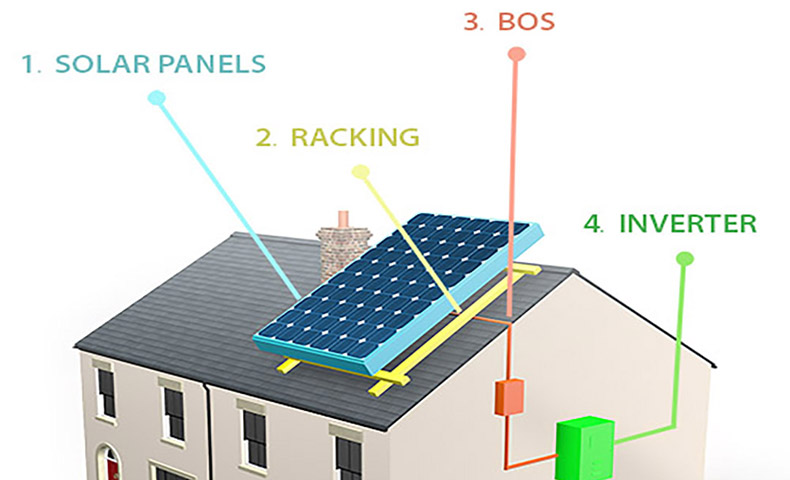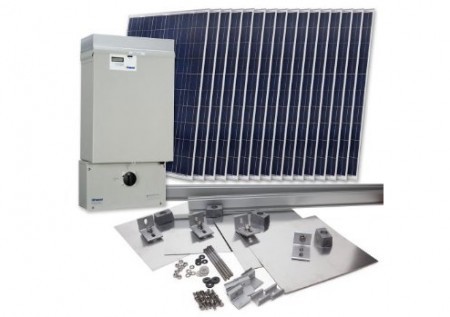
This year, Tyson plans to install a solar system in his remote cabin in Northwestern Ontario, Canada. He needs about 1,300 kWh/yr.
“I have an electrical/electronics background but most of my experience is unrelated (but transferable). I have done a lot of reading on designing an off grid (solar) system. But due to circumstances my design process differs and this is making it hard for me to find the information to figure out some key things.
“Most system designs are based on the question what will the load be? In my case there is no electrical existing (all propane lights and fridge and stove) and everything will be added new,” he said on a message board for solar power questions.
For Tyson and others with a background in electrical or who simply like to do things on their own, a solar panel system kit could be an easy and inexpensive way to get their feet wet with solar power.
Fortune Energy sells some of these kits, that come complete with solar panels, inverter, mounting equipment and other parts, everything you will need to get your solar system up and running.
These kits are available in sizes from 1kW to 1 MW, depending on your needs. If you don’t know exactly which system is best for you or have a specific package in mind, they’ll design it, configure it, pack it and ship it, eliminating the hassle of having to look for different parts at different vendors.
If you’re not so electrically-inclined, solar system kits can still be a cost-effective and easy approach to getting your home on the renewable energy movement. You buy the equipment and simply hire a contractor to install it, saving you some money along the way.
Solar power kits are also a good idea for those, like Tyson above, who want to live in rural, mountain areas with no access to the electrical grid. Or they can also be used in homes and businesses still attached to the grid, but who want to reduce their carbon footprint and save money along the way.

Parts needed
Here are some of the items you need in your solar system kit:
Solar panels: there are two types: monocrystalline and polycrystalline. They’re most distinctly differentiated by their color - mono, black; poly blue.
Monocrystalline solar panels are the oldest technology and tend to have the highest efficiency rates when it comes to energy production. However, they tend to be more expensive.
Polycrystalline solar panels tend to have slightly lower heat tolerance than their counterparts, and thus might produce less energy, but as the technology increases, these differences are minor.
Either way, the solar panels are responsible for collecting energy from the sun and transforming it into direct current (DC).
Solar Inverter: this very important piece of equipment converts DC current into alternating current (AC) – the type of electricity you get when you plug your electronics at home. Make sure to match the capacity of your solar inverter with the size and type of your system (based on the number of kW and grid or off-grid systems).
There are four main types. Microinverters are small devices mounted on the back of each solar panel. They provide for better management of individual solar panel monitoring.
String inverters control many solar panels grouped together.
Hybrid DC optimizers and string inverters feature small devices (DC optimizers) that manage 1 or 2 solar panels at a time to help them produce the most energy without impacting the other panels in a string. These are helpful when a particular panel is compromised by loss of efficiency, which can impact the others.
Central inverters are the best option for solar power system of 5MW or above. These are large, high capacity inverters that are at least 1 MW AC or more.
Battery: if you’re off-grid you need it to store the energy you will need at night when the solar panels are not generating electricity. A battery stores the energy from the solar power system on its amp hour rating. Amp hours mean the amount of amps of current that a battery could output in one hour before needing a charge. The higher the amp hour rating, the longer it will discharge power.
PV Disconnect allow you to power off your system for maintenance and repairs. If you live in California, the state requires this device, which must be manually operable in the event of a power supply failure.
Electrical Panel: Your breaker box – how the solar energy you gather connects to your establishment.
Net Meter: If you’re connected to the electrical grid, this device monitors the amount of power you’re receiving from the grid and the extra energy your sending it. Depending on your electricity needs and the size and type of your equipment, you may achieve net-zero, which means you don’t need any electricity from the grid and can even receive credit from contributing to it.
HahaSmart Blog - More Solar Tips and Guide
HahaSmart News - Stay Informed
Your Solar Incentives - See Credits and Incentives in Your Area
Check Your Home's Solar Price - See How Much You Save
Register Now - Unlock The Lowest Solar Prices in Your Area


Input your address to see if it is solar friendly and how much you can save with solar.
Great. Your address is perfect for solar. Solar incentive is still available. Select monthly utility cost and calculate the size of solar system you will need now.
| kw System size | years Payback period | Lifetime savings |
No money down, 100% finance is available.
|
|
To find the lowest priced solar panels in your area, check here! |
Comments